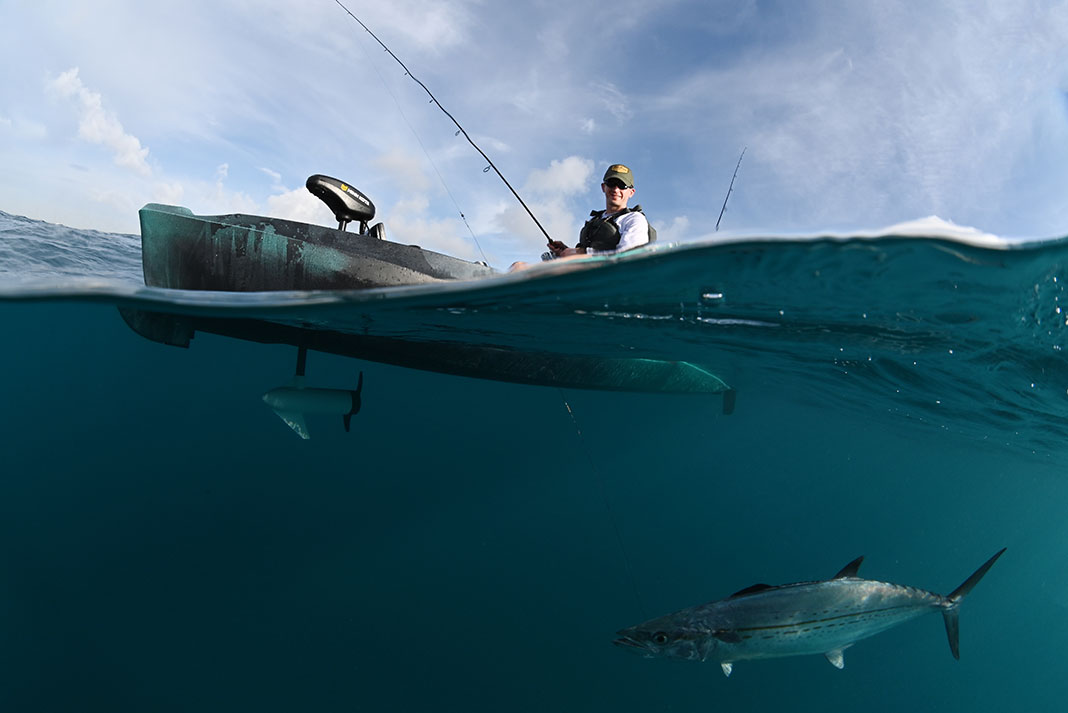The cat is out of the bag. The dam burst. The train has left the station. Motorized kayaks are a part of the sport and there’s no going back. Turns out, effortlessly zooming to a distant fishing destination in a small plastic boat is simple, safe and more fun. Rigging a trolling motor is the least expensive and easiest way to go moto. And, maneuvering like a champ, a trolling motor will get the boat into and out of the tightest jam. There are a lot of reasons to motorize a kayak and a few key decisions to make before getting started.
3 Questions to Answer Before Installing a Kayak Trolling Motor
1 Choosing a motor
Derek Brundle, a tournament angler on the NuCanoe pro staff, fell in love at first sight when he was fishing a small boat tournament and saw a kayak with a trolling motor. “I was blown away by the maneuverability,” he remembers. Brundle put together a NuCanoe Pursuit with a MotorGuide Xi3 motor and he was off to the races.
Brundle recalls the early days: “I used a regular trolling motor and cut the shaft so it would fit my kayak.” Today, trolling motors with a 36-inch shaft are a perfect fit on a kayak. Aftermarket mounting bases and quick-release mechanisms are available for the most popular kayak and motor models. “This makes installation so much easier and safer,” Brundle says.

The game changer is the remote-controlled, GPS-connected brain of the motor. Brundle controls his trolling motor with a remote on a lanyard around his neck. He says, “The precise boat control I get is unmatched and it really is a huge factor in my success.”
Anglers can save a few dollars with a tiller or foot-pedal-controlled model. These systems add a few installation steps and aren’t as convenient as the handheld remote. Sacrificing a little convenience can save some dough; tiller-drive trolling motors are available for around $100 and install in minutes.
2 Bow or Stern?
Mounting the motor on the bow allows precise control of the kayak. Placing the motor in the stern is more efficient for straight-line courses. Derek Brundle mounted his trolling motor on the bow. “I stand and fish all day, so having a MotorGuide Xi3 mounted on the front is definitely the way to go.”
Kerry Peeler, manager at OEX San Diego, has installed trolling motors on nearly every type of kayak. He explains the bow-mount motor’s biggest advantage is the GPS-enabled virtual anchor. The angler pushes a button on the remote and the GPS-controlled motor rotates to hold the kayak in one position. “I can really concentrate on executing my fishing technique without worrying about anchoring,” Kerry says.
While a bow-mount trolling motor is more maneuverable, it is a little slower than a stern-mounted electric outboard. “I see a speed range from 3.7 to five miles per hour,” Kerry says. The slower speeds are due to two factors, Kerry says, “A 12-volt motor only provides a maximum 55 pounds of thrust and the bow-mount motor pulls the kayak which isn’t as efficient as pushing the boat with a stern-mount motor.”
Kerry says weight is another big factor. “Not all kayaks can handle the extra weight of the entire bow-mount motor system.” To handle a 40-pound motor and mount along with a 30-pound battery, the kayak must have the capacity to support the system, tackle, gear and angler.

3 Powering the Motor
As important as choosing the motor is picking the right battery. To run all day, Kerry says a trolling motor requires a minimum of a 12-volt 100-amp-hour lithium battery.
In his kayak, Kerry runs an FPV 110-amp-hour battery and a smaller 3 FPV 17.5-amp-hour battery inside a Group 27 battery box. The two batteries power Kerry’s trolling motor and Garmin LiveScope Plus fish finder system. He attests, “I have run this setup for 14 hours and only used about half the charge.”
This system works great but it isn’t for everyone. Kerry says, “If you don’t plan on fishing all day or covering a long distance, you can get away with a less powerful battery to save weight and money.”
Kerry and Derek Brundle agree, the first step in adding a trolling motor is thinking about how the boat is used. Whether you’re looking for a little kick to get to the fishing grounds or position the kayak while fishing, there is an easy and safe way to add a trolling motor to your kayak.
Wake me up when we get there. | Feature photo: Kerry Peeler










In the words of Lightning McQueen… “Faster than fast, quicker than quick. I am Lightning!”